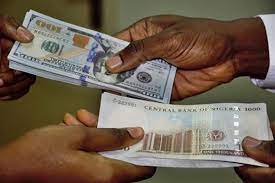
The Nigerian Naira closed the month of April in a steep decline, closing at N1,390.96/$1 in the NAFEM, where the exchange rate trades officially.
This rate represents a 5.8 per cent depreciation from the month’s opening rate of N1,309.39 and a significant drop from its mid-month high of N1,072.74.
The naira rallied against the dollar in the first half of April as a slew of central bank policy actions appear to have stifled speculation.
But things turned worse after the IMF Spring meetings, falling every day since the apex bank addressed concerns over the external reserves.
Meanwhile, this also signifies the 8th consecutive depreciation since the Naira last appreciated to as high as N1,072/$1, following initial enthusiasm over the central bank’s forex policies.
On the parallel market, the unofficial rates quoted were slightly stronger, with data showing a range of N1,350 to N1,380/$1.
According to data from FMDQ, the exchange rate gained marginally on Tuesday April 30th, closing at N1,390.96/$1 compared to N1,419/$1 a day earlier.
The intra-day trading witnessed highs of N1,450 and lows of N1,200, showcasing extreme volatility.
Forex turnover today was significantly lower at $225.36 million, a sharp fall from the $309 million recorded last Friday.
For the month of April, total forex turnover in the official market was reported at $3.94 billion, a significant decrease from the $5 billion recorded in March.
This suggests that the official market has seen a substantial reduction in forex activity.
The external reserves, however, have continued their slow upward trend, now standing at $32.13 billion, marginally higher than the $32.109 billion reported last week.
The recent plummet in the exchange rate can be attributed to a combination of rising demand for dollars, a strengthening U.S. dollar, and increasing inflation rates.
Moreover, the noticeable decrease in forex turnover has also played a significant role in the currency’s decline.
Central Bank Governor, Yemi Cardoso, stated that the volatility in exchange rates is expected to continue due to market forces suggesting that there will be “ups and downs” with rates.
This unstable forex landscape poses significant challenges for Nigeria’s economic stability, impacting both imports and inflation rates.
Following the monetary policy committee meeting on March 28th, the Central Bank voted to raise the policy rates from 22.75% to 24.75%.
This decision set the tone for higher interest rates, paving the way for an influx of forex as the Debt Management Office sold trillions in treasury bills at yields above 19%.
The Central Bank also resumed selling forex to Bureau De Change (BDC) operators after lifting a previous ban and introducing a new set of guidelines aimed at curbing speculation and corrupt practices.
The apex bank sold forex to BDC operators at rates significantly lower than those quoted on the official NAFEM market.
As the IMF Spring meetings approached, reports surfaced that the country’s external reserves had decreased by over $2 billion, falling to their lowest level in two years.
The CBN maintained that the decline in reserves was not due to defending the naira but was in line with obligations that had fallen due.







